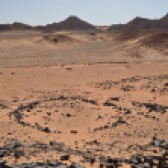The May-June 2012 fieldwork season took place in the study area of al-Thulaythuwat. The area of al-Thulaythuwat is located in a remote desert landscape of southern Jordan, at some 60 km south of al-Jafr and 60 km north-east of al-Mudawwara. During the fieldwork, work focused on 3 of the 4 scientific themes defined for the project. The fieldwork operations were documented using photography, sketches and drawings as well as aerial vertical photography using a kite.
At first, it is on the question of the chronology (theme 1) and the study of camps and the development of the phenomenon of nomadic pastoralism (theme 2) that concentrated the efforts during this campaign. The preliminary study stemming from the previous survey undertaken in the area (campaigns 2007 and 2008) allowed to move forward the hypothesis of the existence of a pole of pastoral nomadic activity, represented by a concentration of camps attributed to the Chalcolithic/Early Bronze Age in a specific sector of the study area. the excavations undertaken during this season allowed to highlight stratigraphical situations sometimes more complex than the image obtained from the simple surface examination. In spite of the relatively low sedimentation, it was possible to reach in several cases occupation layers represented by ashy surfaces and floors, as well as hearths.
In a parallel to the study of the occupation in the stone circle enclosures, a second phase of the fieldwork season in the area of al-Thulaythuwat was dedicated to the study of the funerary installations, within the framework of the theme 4 of the scientific project. During the preliminary campaigns of exploration (2007 and 2008), numerous cairns were identified in the sector of al-Thulaythuwat. These are concentrated along the escarpment of more than 100 m of height, which crosses the zone of study from east to west, overlooking the alluvial plain to the south. During these first operations, the excavation of two cairns allowed to confirm the funeral nature of these installations and to establish a first report on the mode of construction and the burial practices represented (cf. 2008 season report). The concluding results obtained encouraged us to pursue the study of this megalithic funeral phenomenon, which seems to extend far into the southeastern desert of Jordan.











